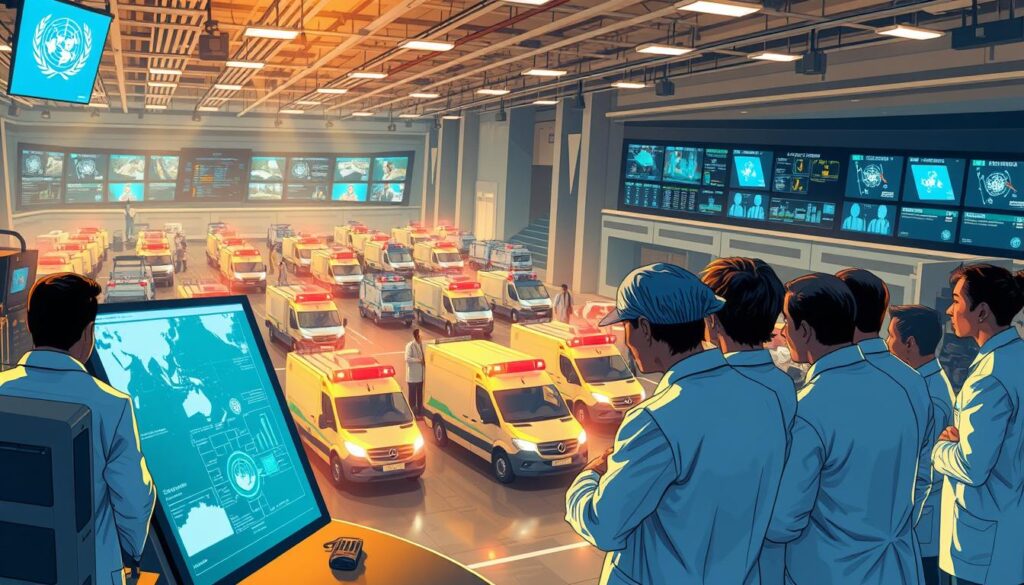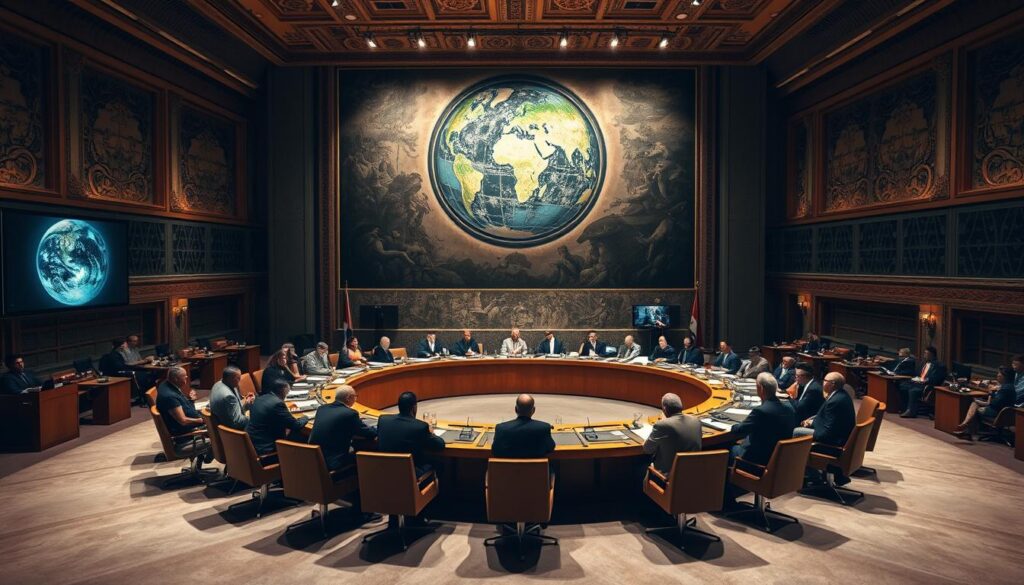The World Health Organization (WHO) is key in global health. It helps 190 million people worldwide with health issues.
As the top global health agency, the WHO works to improve international public health. It uses science to help everyone get healthcare. It also leads during health emergencies.
The WHO’s work is vital for health worldwide. Its efforts are making a big difference globally.
Key Takeaways
- The WHO is the leading authority on global health issues.
- Its mission is centered around promoting health for all.
- The organization plays a crucial role in global health governance.
- It provides critical guidance and support during health crises.
- The WHO’s work has a significant impact on international public health.
The History and Evolution of the World Health Organization
The WHO has grown a lot since it started in 1948. It aims to improve health for everyone. It does this by being fair, honest, and inclusive.
Exploring the WHO’s Founding and Original Mission
The WHO was created to help everyone get the best health possible. It wanted to make the world a safer place for health. It started by fighting diseases like malaria and tuberculosis.
Tracing Key Historical Milestones and Achievements
The WHO has made big strides over time. It wiped out smallpox in 1980, a huge win. It also set up rules for stopping diseases and improving health systems around the world.
Understanding How the WHO’s Mandate Has Evolved
The WHO now tackles new health problems like non-communicable diseases and climate change. It has changed its ways to handle these issues. It focuses on making sure everyone has access to health care.
The WHO keeps adapting to the world’s health needs. It stays important in making the world healthier for everyone.
Navigating the Organizational Structure of the WHO
The World Health Organization (WHO) has a complex structure. It plays a key role in global health governance. This structure helps the WHO tackle global health issues through its leadership, governance bodies, and regional offices.
Key Leadership Positions and Governance Bodies
The WHO is led by the Director-General, chosen by the World Health Assembly (WHA) for five years. The WHA is the WHO’s top decision-making body, with representatives from all Member States. It sets the WHO’s direction and makes important health policy decisions.
“The World Health Assembly is the supreme decision-making body for the WHO, and its role is pivotal in shaping global health agendas,” as emphasized by the WHO’s reports.
Locating and Utilizing Regional Offices
The WHO has six regional offices. They are in Africa, the Americas, South-East Asia, Europe, the Eastern Mediterranean, and the Western Pacific. These offices help implement WHO policies at the regional level. They work with Member States to tackle health issues and offer technical help.
How WHO Funding Works
The WHO gets money from Member States’ assessed contributions and voluntary donations. The WHA approves the WHO’s budget. The money goes to support WHO programs and activities worldwide.
As noted by the WHO, “sustainable financing is critical to ensuring the long-term success of our global health initiatives.” This shows how important a steady funding source is for the WHO’s work.
How the World Health Organization Sets Global Health Priorities
The World Health Organization (WHO) is key in setting global health priorities. As a leading global health agency, it identifies and tackles pressing health issues worldwide. It makes sure its efforts match the needs of its member states.
Participating in the World Health Assembly Process
The World Health Assembly (WHA) is the WHO’s decision-making body. It includes representatives from all member states. We take part in WHA discussions, negotiations, and decisions on key health issues.
This process helps shape health policy and sets priorities for global health initiatives.
Analyzing Current Strategic Planning Frameworks
The WHO uses strategic planning frameworks to guide its work. We analyze these frameworks to understand their development and impact on global health. By looking at these frameworks, we see the WHO’s role in international public health.
Identifying How Competing Health Priorities Are Balanced
Balancing competing health priorities is a big challenge for the WHO. We see how the organization tackles this by looking at disease burden, resource availability, and population needs. Understanding this helps us see how effective the WHO’s health policy initiatives are.
Accessing WHO’s Disease Prevention and Control Programs
The World Health Organization (WHO) is key in global health. It has many programs to stop outbreaks and manage chronic diseases. These efforts aim to better health worldwide.
The WHO has infectious disease surveillance systems. These help countries watch and act on disease outbreaks.
Using the WHO’s Infectious Disease Surveillance Systems
The WHO’s systems are vital for spotting and handling health threats early. Key features include:
- Real-time data collection and analysis
- Standardized reporting formats
- Technical assistance for countries to strengthen their surveillance capabilities
Implementing WHO Vaccination and Immunization Guidelines
The WHO gives detailed guidelines on vaccines and immunization. These guidelines cover:
- Vaccine safety and efficacy
- Immunization schedules
- Strategies for vaccine distribution and delivery
Applying WHO Approaches to Chronic Disease Management
The WHO also works on chronic disease management. It offers frameworks and tools for countries to tackle diseases like diabetes and heart disease. Key approaches include:
- Promoting healthy lifestyles
- Improving healthcare delivery systems
- Enhancing patient education and self-management
By using WHO resources, countries can boost their disease prevention efforts. This leads to better health for everyone.
Finding and Utilizing WHO Resources and Data
The WHO is a global health leader, offering a wealth of resources and data. These are crucial for researchers, policymakers, and health workers. The WHO’s dedication to better health is shown in the vast information it shares.
Navigating the WHO Website and Digital Tools Effectively
The WHO website is packed with health data and resources. To use it well, we should get to know its layout. It has sections for different health topics, publications, and data. The search function is also handy for finding specific info.
Accessing and Applying Research Publications and Reports
The WHO releases many research papers and reports. These are key for grasping global health trends and issues. You can find these on the WHO website by searching the publications database. Using these reports can help us make better health decisions and policies.
Interpreting WHO Health Statistics and Databases
The WHO has detailed health statistics and databases. These give us important insights into global health. To understand them, we need to know how the data is collected and analyzed. The WHO website helps us learn how to use these databases, so we can make informed choices.
Monitoring the WHO’s Emergency Response Mechanisms
The WHO’s emergency response plans tackle global health crises head-on. As the top global health leader, the WHO is key in coordinating health emergency responses.

Understanding the Public Health Emergency Declaration Process
The WHO has a clear process for declaring a Public Health Emergency of International Concern (PHEIC). The Emergency Committee thoroughly assesses the situation. Their advice to the Director-General can lead to international actions to fight the outbreak.
“The determination of a PHEIC is a serious matter and requires careful consideration of the evidence and the potential consequences.” – WHO Director-General
Following WHO Pandemic Preparedness and Response Guidelines
The WHO offers detailed guidelines for pandemic readiness and response. These guidelines help with surveillance, risk assessment, and countermeasures. Countries are urged to create their own plans based on WHO advice for a unified global effort.
| Guideline Component | Description |
|---|---|
| Surveillance | Early detection and reporting of potential outbreaks |
| Risk Assessment | Evaluation of the severity and potential impact of an outbreak |
| Countermeasures | Implementation of measures to contain and mitigate outbreaks |
Accessing Humanitarian Health Assistance Resources
The WHO provides many resources for humanitarian health help. This includes guidelines, training, and operational support. These tools are vital for addressing health needs in emergencies, like natural disasters or conflicts. They help countries and groups improve their emergency response skills.
Engaging with WHO’s Collaborative Networks
The WHO works with many groups to help people worldwide. These partnerships help share knowledge and resources. They are key to solving big health problems.
Connecting with WHO Through Member State Channels
The WHO teams up with countries to improve health. Countries get help and share ideas through these channels. For example, the WHO’s Communication Framework helps talk about health issues clearly.
Leveraging WHO’s Partnerships with Other UN Agencies
The WHO works with other UN groups to do more good. These partnerships bring in new skills and help. For example, working with UNICEF and UNFPA has helped more moms and kids stay healthy.
Participating in WHO Collaborations with NGOs and Private Sector
The WHO also teams up with NGOs and private companies. These partnerships bring new ideas and help. They help with vaccines, tracking diseases, and making health systems better.
| Partnership Type | Description | Benefits |
|---|---|---|
| Member State Channels | Technical assistance, best practice sharing | Improved health outcomes, coordinated responses |
| UN Agencies | Expertise and resource sharing | Enhanced global health impact |
| NGOs and Private Sector | Innovative solutions, resource mobilization | Accelerated health progress, strengthened health systems |
Assessing the WHO’s Impact on Global Health Outcomes
The WHO’s impact on global health is complex. It has made big strides and faced big challenges. The organization has improved health worldwide.
Major Achievements
The WHO has won many battles, like eradicating smallpox. It also set up guidelines for preventing and controlling diseases. These wins show the WHO’s power to change global health.

Measurement Frameworks and Indicators
The WHO tracks its success with various tools. These help it see how well its programs work. They also show where it can do better.
| Indicator | Description | Impact |
|---|---|---|
| Life expectancy | Measures the average number of years a person is expected to live | Increased life expectancy indicates improved health outcomes |
| Maternal mortality ratio | Measures the number of maternal deaths per 100,000 live births | Reduced maternal mortality ratio indicates improved healthcare for mothers |
| Under-5 mortality rate | Measures the number of deaths among children under 5 per 1,000 live births | Reduced under-5 mortality rate indicates improved healthcare for children |
Challenges and Limitations
The WHO has many hurdles to overcome. It deals with limited funds, complex health issues, and tough choices. These challenges make its job hard.
Understanding these issues helps us see the WHO’s role in global health. It shows the complexity of health policy and governance.
Understanding Controversies and Reforms in WHO Governance
The WHO plays a key role in global health. It faces many criticisms and reforms. The WHO leads, coordinates, and makes policies in health.
It has dealt with many challenges and controversies. These have affected its ability to work well and stay independent.
Analyzing Political Influences and Independence Concerns
The WHO works in a world with many political forces. These can change how it makes decisions. There are worries about the WHO’s freedom, mainly because of funding and possible biases.
Independent decision-making is key for the WHO. It helps the organization stay credible and effective in health issues.
Tracking Current Reform Initiatives and Organizational Changes
The WHO has started many reforms to improve. These aim to make its governance, transparency, and accountability better. The reforms focus on better planning and program work.
They also aim to strengthen partnerships with other health groups. Keeping up with these changes helps us see how the WHO’s role in health is changing.
| Reform Area | Description | Impact |
|---|---|---|
| Governance | Enhancing decision-making processes | Improved transparency and accountability |
| Program Implementation | Strengthening program delivery and monitoring | More effective health interventions |
| Partnerships | Fostering collaborations with global health actors | Enhanced coordination and resource mobilization |
Anticipating Future Directions for WHO Governance
The WHO must keep up with the changing health world. It needs to be more agile and quick to respond to health crises. It also needs to work better with other health groups.
Looking ahead, the WHO’s future is important. It will help us get ready for the future of health governance.
Conclusion: The Future Role of the WHO in Global Health
The World Health Organization is key in global health, tackling big issues that affect people everywhere. It works on preventing diseases and responding to emergencies. Its efforts are seen all over the world.
The Western Pacific Region, with nearly 1.9 billion people, faces many health problems. These include diseases, ageing populations, and climate change impacts. The WHO’s Thirteenth General Programme of Work aims to tackle these issues. It focuses on improving health by 2030, as part of the Sustainable Development Agenda.
The WHO is a leading force in global health. It’s ready to tackle new health challenges. We need to keep supporting the WHO to make health better for everyone. Together, we can help the WHO lead in improving health worldwide.


